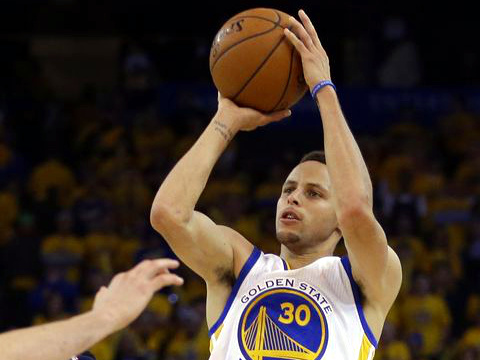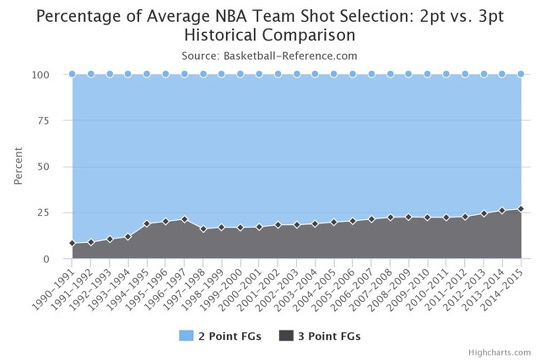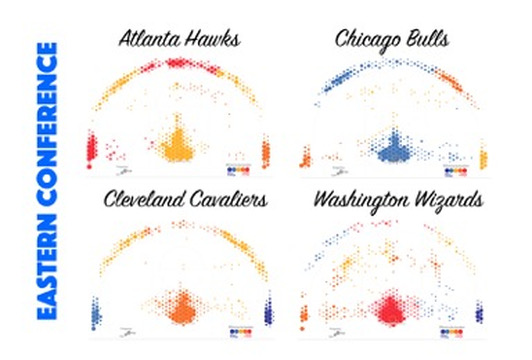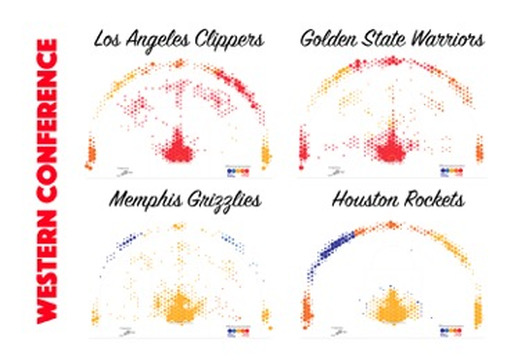
Over the past decade, the NBA has changed dramatically. It’s fitting, then, that a player who typifies the new style of the NBA, Stephen Curry, was named the league’s Most Valuable Player earlier this week. Curry, a deadly shooter from all parts of the court, boosted his team, the Golden State Warriors, to the top of the Western Conference. They handily beat the New Orleans Pelicans in their first round matchup, and now find themselves in a tough contest against the Memphis Grizzlies in the Western Conference semi-finals.
If you’ve followed basketball for a while, you’ve no doubt noticed the change in the game. In the 1990’s, during the height of the Michael Jordan era, when the Chicago Bulls were kings of the NBA, the league was all about isolation plays and low-post one-on-one basketball. Jordan destroyed opponents with his unique combination of jump shooting and tenacity in attacking the basket. Most teams in that era had imposing frontlines with plenty of bruising big-men for these epic low-post battles. Dikembe Mutombo, Shaquille O’Neal, Hakeem Olajuwon, Alonzo Mourning, David Robinson, Patrick Ewing, Dennis Rodman, Charles Oakley, Vlade Divac, and Karl Malone were all superstars of 90’s NBA basketball, and were flanked by mostly jump-shooting guards who patrolled the midrange.
Back in this era of basketball, hard fouls were the norm. Players didn’t like each other. All of this contributed to the NBA’s vast popularity. It had the most iconic sports figure of the decade in Michael Jordan, a host of good teams and other superstars, and intense rivalries that fueled competition.
But as the 90s waned and the new century dawned, many of these stars faded, and a new crop of NBA players took the mantle. The problem, though, was that they just weren’t as good at the style of isolation play the 90s superstars. Scoring decreased across the league, and games became tedious one-on-one battles, where teams would slowly walk up the court, pass the ball to their best player, and clear out a side of the court for him to take his defender one-on-one. This resulted in a lot of bad shots, and no real offensive flow.
League interest was waning, as the on-court product lacked pizazz and teams had fewer superstars. So the league’s rule-makers, led by Jerry Colangelo, decided to drastically change the game. Two key changes emerged: first, in 2001, the league ok’ed zone defense, and second, in 2005, began enforcing the hand-check rule. The permission of zone defense allowed teams to clog up the two areas where baskets had heretofore been rather easy: the midrange and low-post. The enforcement of the hand-checking rule (first established in the mid-90s but only enforced a decade later) took away a key weapon for perimeter defenders of being able to feel where a player was going to drive and ever-so-slightly use the offensive player for better leverage and balance. The hand-checking rule enforcement greatly reduced perimeter defenders ability to stop a good guard.
It took the NBA a while to acclimate to these new changes, but we’re now seeing the fruit of those two key rule changes. The result has been a renewed emphasis on two key dimension of offense: shooting and passing. Teams have begun embracing statistical analysis, and have minimized the number of midrange jump-shots they take, while significantly increasing the number of 3-point shots attempted. Look at the following graph, which visually shows the increase in use of the 3-point shot from the 90’s to today.
 Few teams rely on the 90’s favorite play: the clear-out. Now, the best players are given the ball at a specific spot on the court, while the rest of their team uses picks and screens to provide constant movement and passing opportunities for the ball-handler to find a spot-up shooter. The overall result is teams embracing a flow style of offense, where precision passing merges with off-the-ball movement and three-point shooting specialists. Using statistics, teams have found that it’s much more favorable to attempt 3-pointers than midrange jumpers, and especially corner threes, where the arc of the 3-point line is closest to the rim. Combine this with high-percentage shots around the basket, and the modern NBA offense is largely based on 3-point shooting and close-to-the-rim shots. Check out the following shot charts from both the Western Conference semi-finalists and the Eastern Conference semi-finalists in this years playoffs.
Few teams rely on the 90’s favorite play: the clear-out. Now, the best players are given the ball at a specific spot on the court, while the rest of their team uses picks and screens to provide constant movement and passing opportunities for the ball-handler to find a spot-up shooter. The overall result is teams embracing a flow style of offense, where precision passing merges with off-the-ball movement and three-point shooting specialists. Using statistics, teams have found that it’s much more favorable to attempt 3-pointers than midrange jumpers, and especially corner threes, where the arc of the 3-point line is closest to the rim. Combine this with high-percentage shots around the basket, and the modern NBA offense is largely based on 3-point shooting and close-to-the-rim shots. Check out the following shot charts from both the Western Conference semi-finalists and the Eastern Conference semi-finalists in this years playoffs.
 |
 |
Only the Wizards and Clippers have significant midrange jump-shooting as part of their offense.
What is the lesson with all of this? True freedom needs constraint. Successful teams need a cohesive unit where all players are symbiotically working together in a set style of play. What looks like a collage of constant movement is actually the work of thousands of hours of practice. The San Antonio Spurs, who won last year’s championship, perfectly embody this renewed emphasis on system basketball. This year, The Golden State Warriors and Stephen Curry look to take the mantle from the Spurs by combining pure shooting with dizzying ball movement. For each of these teams, the creativity that emerges on the court is a result of the complex system that their coaches have drilled into them.
You and I have been given ultimate freedom in Christ (Galatians 5:1). But we find in the journey of faith that this is not the same kind of freedom that the world thinks is freedom. Christian freedom is glad submission to our King, Jesus, and finding our identity in relation to what He says about us. Christian freedom is not God granting your every desire and fulfilling your every wish. It is finding joy in submitting to Jesus, and allowing Him to change us and transform us into what we could not become on our own. A good artist will you tell that it takes lo
ts of hard work, and a surprising amount of discipline to create great art. Similarly, the true Christian life of freedom is not accidental, but is first the gracious gift of God that we must receive, which then calls forth grateful submission and discipline in order to fully cultivate the fruits of the Spirit that God grows inside us.
The result of freedom from constraint in the NBA is a beautiful style of basketball that is bringing about a renaissance of sorts in the game. The result in our Christian lives is the flowering and flourishing of the fruits of the Spirit.













